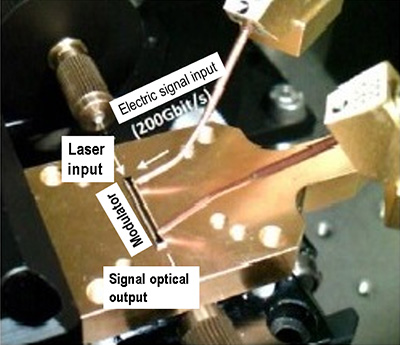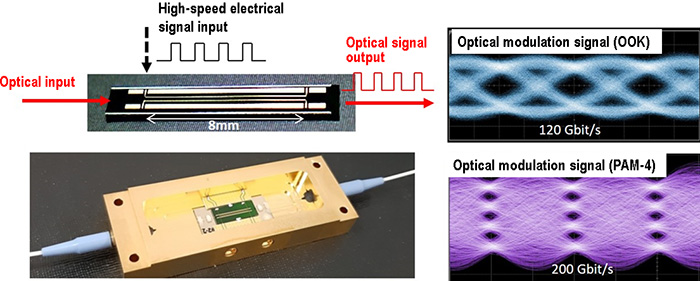Research Results
New technologies to support future information communications
World's fastest optical data transmission with "polymer optical modulators"FY2022

- Yokoyama Shiyoshi (Professor, Institute for Materials Chemistry and Engineering, Kyushu University)
- S-Innovation
- Strategic Promotion of Innovative Research and Development
Development of advanced information communications technology using photonics polymer
Researcher, Optical interconnect device technology using high-performance photonics polymers (2015 -2018) - Adaptable and Seamless Technology Transfer Program through Target-driven R&D (A-STEP)
- Industry-academia collaboration phase (Seeds development type)
"Development of 1Tb/s polymer photonic integrated circuit devices", Research Director (2019-2021) - SICORP
- Japan-Germany International Industry-Academia Collaborative Research (Optics and Photonics)
"Efficient Silicon Photonic Device Using Advanced Electro-Optic Polymers ," Research Leader in Japan (2018-2021)
Succeeded in ultra-high-speed optical modulation with "polymer optical modulator"
High-definition video that flows continuously. Smooth movement and vivid graphic game screens. Now, anyone can benefit from high-speed communication at any time. The rapid development of information and communication technology supports this convenience.
The traffic amount of information and communications has increased dramatically, and the hardware responsible for communication technology is required to have higher performance and significantly reduced power consumption. An optical modulator is a device that uses electro-optic properties (*1) to convert electrical signals into optical signals at high speed, and is a key device for optical fiber communication that can transmit enormous amounts of information at high speed. Since the speed of optical modulation greatly affects the amount of information communication, efforts have been made to increase the modulation speed. Until now, inorganic materials have been used, but there were limits to the speed and power consumption. Thus, great expectations are currently placed on the implementation of optical modulators using electro-optic polymers, which can realize high speed and low power consumption. However, polymers have problems with the reliability such as thermal stability, and it has been difficult to put them into industrial use.
Research group has developed materials to realize highly reliable polymer modulators. They have fabricated an ultra-high-speed optical modulator using an electro-optic polymer (*2), and achieved the world's fastest optical data transmission of 200 Gigabits per second in 2020. It is expected to be used in the field of optical fiber communications where energy saving and cost reduction are desired at the same time as high speed.
*1 Electro-optic properties
A phenomenon in which the refractive index of light changes when an electric field is applied to a material. Such properties of a material are called electro-optic properties.
*2 Electro-optic polymer
Polymer-based electro-optical materials are expected to become next-generation materials because of their advantages such as high speed, workability, and low cost.

Fig. 1 Ultra-fast optical modulator using electro-optic polymer
Laser light input to a polymer optical modulator is modulated by a high-speed electrical signal, and transmitted as an optical signal through an optical fiber.
Challenges for the future communication environment
Ethernet standard is mainly used for wired computer networks. The overall transmission speed of the Ethernet optical transmission standard (*3) is increasing year by year. The development roadmap predicts a link speed of from 800 Gigabit Ethernet (*4) up to 1.6 Terabit Ethernet by 2025. This predicted increase is more than several times higher than the 400GbE that is currently being implemented.
With the worldwide increase in communication traffic, the role of data centers capable of efficient signal processing is becoming more important, and their scale is also increasing. In data centers, more efficient electric and optical signal processing capacity is the first priority. At the same time, the power consumption of equipment due to the densification of hardware and the rapid increase in power consumption for air conditioning management have become major problems. In order to solve these problems, it is necessary to develop an optical communication technology that enables ultra-high signal processing at low power consumption and low cost. For that purpose, it is important to develop new devices using innovative materials that never existed before, and to promote their practical application.
Electro-optic polymers have highly enhanced electro-optic coefficient and frequency response, and these characteristics are motivating the further development of optical devices made from polymers. In recent years, excellent research results have been shown by research groups around the world who have focused on high-speed polymer modulator. However, polymers have problems such as unreliable thermal stability, and it has been difficult to put them into practical use.
Regarding the reliability of devices, which has been difficult to solve, this research group has been engaged in the development of materials with excellent durability and reliability as well as research on performance improvement of optical modulator.
*3 Ethernet optical transmission standard
An international communication standard for fiber-optic networks. In 2017, a standard with a maximum transmission speed of 400 Gbit/sec was established.
*4 Gigabit Ethernet
A signal network specification having a communication speed of Gigabits/sec (Giga means 1 billion). Terabit Ethernet is three orders of magnitude faster.
Reliable polymer optical devices for high speed and energy-saving
Professor Yokoyama's research group has been working on the development of electro-optic polymers in collaboration with Nissan Chemical Corporation, and achieved the reliability of devices without performance deterioration even in a high-temperature environment at 100°C or higher. The group has succeeded in developing an electro-optic polymer that has high thermal stability, and can demonstrate high-speed optical signaling even at 110°C.
In addition, in the experiment of optical signal transmission using an ultra-high-speed optical modulator of the electro-optic polymer, they demonstrated up to 200 Gigabits per second signaling. So far, they had been studying high-speed optical modulation of 100 Gigabits per second, but with the results of this research, it is now possible to achieve even twice the speed.
Electro-optic polymers are theoretically predicted to have high-frequency response of 100 GHz or more, and further bandwidth expansion can be expected in the future.
It was also found that the device operating voltage was suppressed to 1.3 volts from the previous 1.5 volts. This level can be converted to the power consumption per bit of 42 femtojoules(*5) as a very small power consumption characteristic.
High-performance optical modulation devices that consist of inorganic materials and semiconductors (lithium niobate, silicon, indium phosphide, etc.) are continued to be developed. Under such circumstances, it was a great achievement to realize a polymer modulator that has better high-frequency response, high-speed signaling, power consumption, and thermal stability.
*5 Femtojoules
"fJ". Joule is a unit of energy, work, heat, and electric energy. Femto means 10-15 times (1/1000 trillion).

Fig. 2 Developed electro-optic polymer light modulator
Photograph of electro-optic polymer modulator, and optical modulation characteristics of OOK method and PAM-4 method (above: OOK method, below: PAM-4 method) (*6)
*6 OOK and PAM-4 methods
OOK (On-Off-Keying) type signals are transmitted with two values, ON-OFF. For PAM-4 (Pulse-Amplitude Modulation) signals, the transmission rate can be doubled by using pulse signals (four values) with four voltage levels
New communications technologies toward autonomous driving and artificial intelligence
The polymer modulator capable of transmitting optical signal over 200 Gigabits, which is the result of this research, is expected to be applied to large-capacity optical signal processing and communication technologies in such as data centers. In the current optical transmission technology, a transmission method using multiple optical modulation chips in parallel (25 Gigabits x 4 units, etc.) is used to generate optical signals exceeding 100 Gigabits. The polymer modulators that were successfully developed here can generate a 200 Gigabit signal on a single chip. Parallelization will make it possible to extend link speeds to 800 Gigabits and even 1.6 Terabits.
The hybrid silicon optical integration technology, which is particularly suited to integration and miniaturization, with polymers will enable further energy-saving, miniaturization, and integration. The technology is expected to be applied to the high-density data centers and to further explore toward new optical device technologies. In the future, in addition to data center applications, the development of polymer optical communication devices that can be used for various information processing technologies such as autonomous driving, IoT, and artificial intelligence is awaited.
